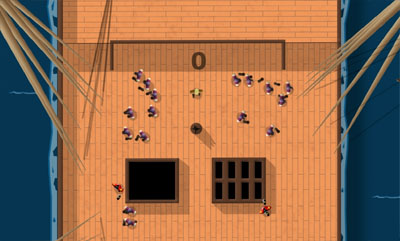January 20th, 2013 (edited November 3rd, 2022)
game jam
super pirate box
postmortem
Last weekend, I participated in a 48-hour game jam with UCI's Video Game Development Club. I had a lot of fun pulling a couple of 14-hour workdays with my fellow game developers. Together, we turned out four games in the weekend, spanning platforms including XNA, Unity, and SDL.
I decided to use my weekend to learn more about using SDL with C++ to develop a 2D game. I spent some time in the preceding weeks writing some libraries for spriting and controls to simplify the process, but of course, there were still a few issues during the weekend. For one thing, I hadn't realized that SDL doesn't load PNG images natively. I was able to implement the SDL_image library, but that set me back a bit.
Anyway, the game itself it an arcade-style top-down game. You play as a pirate who must repel legions of enemy pirates who try to board your ship. However, for some reason neither you nor any of the other pirates have weapons. So what do you do? You attempt to shove them overboard, of course. It's fast-paced action, easy to pick up, but difficult to master - and one slip-up means starting over from zero!
I hope to be able to wrap the game up within a week with some basic menus and online highscores.

Update: Get the game on the project page.











